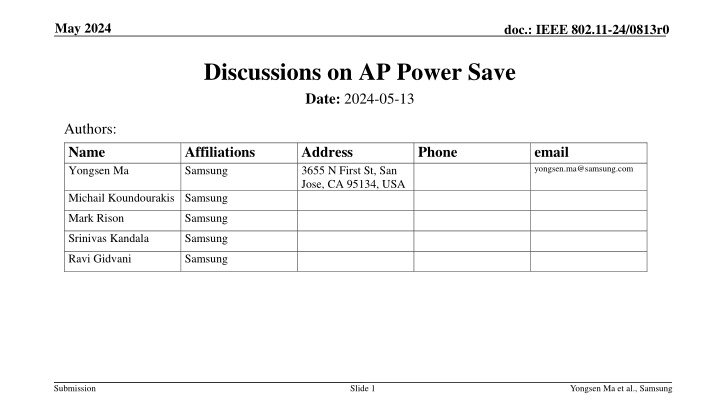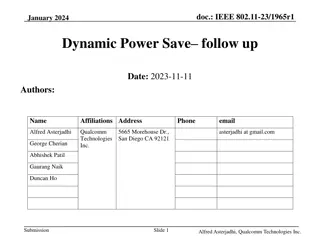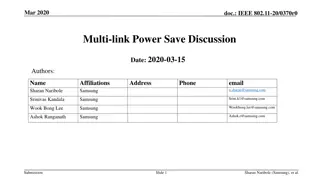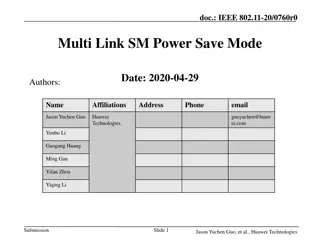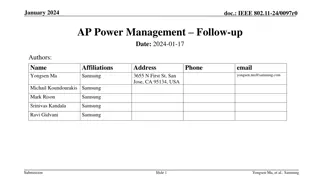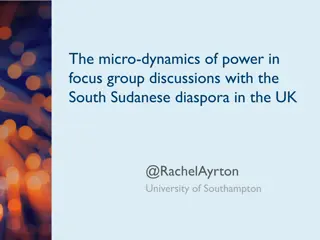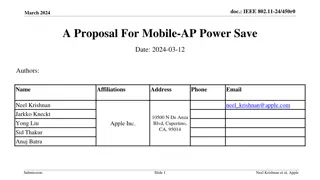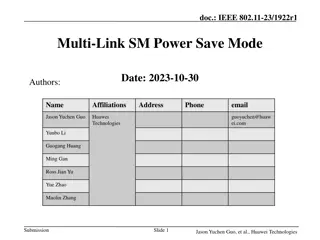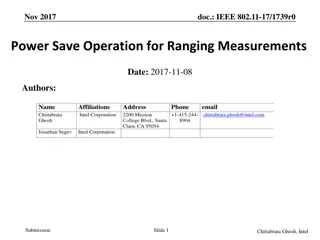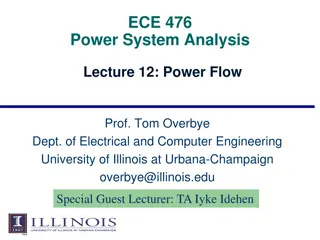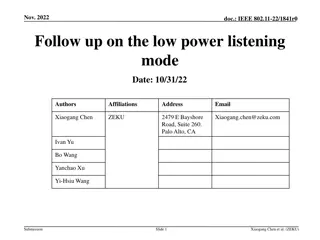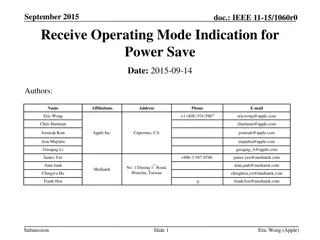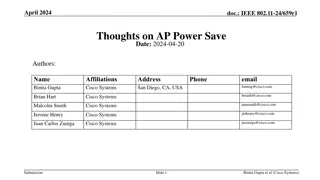Discussions on AP Power Save
The document discusses a proposal on scheduled AP power save in IEEE 802.11-24/0813r0, focusing on improving energy efficiency while maintaining functionality and performance. It covers procedures, operations, information elements, and options for scheduling APs and non-AP STAs.
Download Presentation

Please find below an Image/Link to download the presentation.
The content on the website is provided AS IS for your information and personal use only. It may not be sold, licensed, or shared on other websites without obtaining consent from the author.If you encounter any issues during the download, it is possible that the publisher has removed the file from their server.
You are allowed to download the files provided on this website for personal or commercial use, subject to the condition that they are used lawfully. All files are the property of their respective owners.
The content on the website is provided AS IS for your information and personal use only. It may not be sold, licensed, or shared on other websites without obtaining consent from the author.
E N D
Presentation Transcript
May 2024 doc.: IEEE 802.11-24/0813r0 Discussions on AP Power Save Date: 2024-05-13 Authors: Name Yongsen Ma Affiliations Samsung Address 3655 N First St, San Jose, CA 95134, USA Phone email yongsen.ma@samsung.com Michail Koundourakis Samsung Mark Rison Samsung Srinivas Kandala Samsung Ravi Gidvani Samsung Submission Slide 1 Yongsen Ma et al., Samsung
May 2024 doc.: IEEE 802.11-24/0813r0 Abstract Previous contributions [1, 2] A proposal of scheduled AP power save to improve the energy efficiency of APs while limiting the negative impact on functionality and performance Procedures and operations for AP and non-AP STAs Information elements and options for scheduling, power state, power state transition, capability, and management information This contribution presents a follow up of discussions on AP power save Scope and requirements: infrastructure APs, mobile APs, soft APs; network level Legacy STAs: different versions/generations, scenarios, requirements Presence Request and scheduling information Coexistence with unscheduled/dynamic power save Additional information or actions Submission Slide 2 Yongsen Ma et al., Samsung
May 2024 doc.: IEEE 802.11-24/0813r0 Recap: AP Power Save Proposal The AP balances power save levels and performance requirements by adjusting its scheduling and capability. In the scheduled time window, the AP may operate in different states and capabilities [1, 2] Doze state: e.g., AP MLD in Doze state on certain link(s) with no TID mapped (link disabled) Reduced functionality: e.g., AP MLD having certain link(s) disabled for user data (no TID mapped) but enabled for management operations, such as Beacons, Probe Response, and some on-demand data Reduced capability: e.g., AP operating in low power mode with BW=20MHz, NSS=1 Submission Slide 3 Yongsen Ma et al., Samsung
May 2024 doc.: IEEE 802.11-24/0813r0 Outline of Discussions Scope and requirements of AP power save Legacy STAs Presence Request Scheduling information Coexistence with other AP power save options Additional information and actions Submission Slide 4 Yongsen Ma et al., Samsung
May 2024 doc.: IEEE 802.11-24/0813r0 Scope and Requirements of AP Power Save The target of previous contributions on scheduled AP power save [1, 2] includes infrastructure APs, soft APs, and mobile APs. As mentioned by some members, power save for infrastructure APs is one of the scopes of UHR UHR proposed PAR [4]: This amendment provides mechanisms for enhanced power save for both Access Point (AP) (including mobile AP) and non-AP stations and improved Peer-to-Peer (P2P) operation compared to Extremely High Throughput MAC/PHY operation. Liaison from WFA re: energy efficiency [5]: The Wi-Fi Alliance Operator Market Segment Task Group (OMTG) are writing to you in support of prioritization of measures to reduced power consumption within the Wi-Fi Access Point for future Wi-Fi standards. Power save for APs, especially for infrastructure APs, should be designed very carefully Legacy STAs Clients need to be able to scan, find the AP and associate, and have data communication On-demand data, e.g., Probe Request, latency sensitive traffic STAs in power save mode Submission Slide 5 Yongsen Ma et al., Samsung
May 2024 doc.: IEEE 802.11-24/0813r0 AP Power Save in Presence of Legacy STAs There should be rules/options to avoid any functional and performance degradation for legacy STAs. Depends on the version/generation/capability of legacy STAs, the AP may enter different power save modes in terms of scheduling and capability, e.g., If there is any legacy STA associated, the AP should not enter absent/disabled/Doze state. The AP may operate in reduced capability mode in presence of legacy STAs Notify STAs of any changes: e.g., OMI, OMN, and Notify Channel Width STAs knowing the changes/schedule (e.g., UHR/EHT/HE) may take actions accordingly STAs not knowing the changes (e.g., non-HT) may operate as normal Improved energy efficiency for the AP because of reduced BW/NSS (+low load) With minimal or none negative impact on legacy STAs The AP may return to full capability based on certain condition/requirement Controlled scenarios may pay less attention to certain legacy STAs E.g., industrial scenarios: the version/generation of STAs is known and fixed Submission Slide 6 Yongsen Ma et al., Samsung
May 2024 doc.: IEEE 802.11-24/0813r0 Presence Request Two different types of Presence Request STAs may request the AP to be present, if the AP is in absent/disabled state on certain link, for example, Presence Request could be done by TTLM: a STA negotiates a TTLM with the AP to enable a link (certain TID(s) mapped) that was previously disabled (no TID mapped) One bit in a request frame, e.g., in ICF or low latency indication: a STA sends a request, low latency indication or certain buffer status report to the AP on one link, and the AP enables another link STAs may request the AP to send out the presence/scheduling/OM info. It can be sent with PS-Poll from a STA that waked up from power save mode to ask the AP to send the current presence scheduling. with Probe Request from a STA such that the STA knows the AP s scheduling and capability after receiving the Probe Response. The previous contribution [2] discusses two options for Presence Request: Single frame/element with a request type subfield (request AP to be present or to send out the scheduling/OM) Separate frames/elements for Presence Request and Scheduling/OM Request Slide 7 Submission Yongsen Ma et al., Samsung
May 2024 doc.: IEEE 802.11-24/0813r0 Scheduling Information The scheduling is intended to provide timing and scheduling information Predictable/repeatable in terms of scheduling, capability, and operating mode of the AP STAs knowing the scheduling may take actions accordingly Some scenarios (e.g., with controlled, predictable, or periodic traffic and channel load) may benefit from the scheduling (pre-determined or dynamically triggered) The scheduling may be long-term, short-term, one-time, repeatable or periodic, and can be used together with unscheduled/dynamic AP power save (more details on the next slide) Scheduling Type and Timing Info Scheduling Pattern Example When, how long and how often Start time, duration, interval, stop time Long-term repeatable/periodic Using TWT [2] Start time, duration, interval (persistent) Long-term repeatable/periodic Using TWT with Persistence subfield = 255 [2] When and how long Start time, duration (long) Long-term one-time Using TTLM [2, 3] Start time, duration (short) Short-term one-time Using TWT in SP level [2] or ICF in TXOP level When Start time (w/o duration or stop time, persistent until explicitly terminated) Long-term one-time Using OMI/OMN [3] Short-time one-time Using ICF/CF-END in TXOP level Submission Slide 8 Yongsen Ma et al., Samsung
May 2024 doc.: IEEE 802.11-24/0813r0 Coexistence with Unscheduled/Dynamic AP Power Save The previous contributions [1, 2] mainly focus on scheduled AP power save in long-term, wherein the AP would be idling or in low duty cycle mode during certain time of the day Socket powered APs/home APs: early mornings APs in enterprise/office/industrial/school campus [6]: off-work hours APs in stadiums/shopping malls: outside of operating hours Can also be used for short-term, such as SP level using TWT Can also be used together with unscheduled/dynamic AP power save Need to have rules and options to avoid any potential issues Submission Slide 9 Yongsen Ma et al., Samsung
May 2024 doc.: IEEE 802.11-24/0813r0 Additional Information/Actions Some existing options/procedures in the current spec can be used for AP power save E.g., TWT, TTLM, OMI, OMN, ICF But existing options/procedures are not specifically designed for AP power save purposes, so it may introduce different issues when used for AP power save Such as efficiency, overhead, performance, fairness, back compatibility, etc. Additional information/actions are needed to extend existing options/procedures or define new procedures for AP power save To address any potential issues To make it easy to implement, operate and scale To work with or utilize existing and new operations, such as multi-link and multi-AP To provide options and interface for upper layers (e.g., network-level AP power save), and interactions among STAs Submission Slide 10 Yongsen Ma et al., Samsung
May 2024 doc.: IEEE 802.11-24/0813r0 Conclusion This contribution presents discussions on AP power save Power save for APs including infrastructure APs, mobile APs, and soft APs, and AP power save needs to be carefully designed, especially for infrastructure APs Legacy STAs: different versions/generations, scenarios, requirements Presence Request and scheduling information Coexistence with unscheduled/dynamic power save Additional information or actions Submission Slide 11 Yongsen Ma et al., Samsung
May 2024 doc.: IEEE 802.11-24/0813r0 References [1] IEEE 802.11-23/1835r0, AP Power Management, Yongsen Ma (Samsung) [2] IEEE 802.11-24/0097r0, AP Power Management Follow-up, Yongsen Ma (Samsung) [3] IEEE 802.11-24/0589r1, Dynamic TID-To-Link Mapping for AP MLD Power Save, Yongsen Ma (Samsung) [4] IEEE 802.11-23/0480r3, UHR proposed PAR, Laurent Cariou (Intel) [5] IEEE 802.11-23/0917r0, Liaison statement from Wi-Fi Alliance re: energy efficiency, Dorothy Stanley (HPE) [6] IEEE 802.11-24/0548r0, Modeling and Generation of Realistic Network Activity, Stefan Tschimben (University of Colorado - Boulder) Submission Slide 12 Yongsen Ma et al., Samsung
